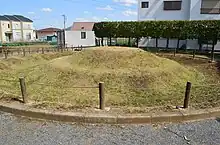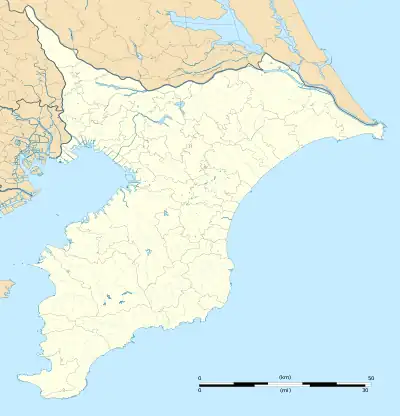 Inaridai Kofun No. 1 Kofun | |
 Shown within Chiba Prefecture | |
| Coordinates | 35°30′12″N 140°7′26.3″E / 35.50333°N 140.123972°E |
|---|---|
| Type | Kofun |
The Inaridai Kofun Group (稲荷台古墳群) is a Kofun cluster or a group of Kofun located in the Chiba Prefecture.[1]
Findings
The cluster includes Inaridai Kofun No. 1 Kofun, which is the kofun the Inaridai Sword was taken from.[2] Some of the earliest pottery in the Kantō region has been found in this Kofun, giving its name to the type.[3]
Location
Located on the west of the Bōsō Peninsula and just east of Tokyo, Inaridai is part of a concentration of early archaeological sites, which also includes Shakujii, in Tokyo's Nerima ward among others. Northeast of these locations are the later sites, categorized as Proto-Jomon. These Proto-Jomon sites are distinguished by pottery that predominantly features fiber or cord impressions.[1]
In the Miura Peninsula, pottery has shell marks. In the Western Kanto Plain, pottery changed from fiber marks to cord marks. Inaridai is a key site in this change.[1]
Usage in periodization
The Kofun cluster gives its name to Inaridai pottery, the oldest pottery type in the Kantō region.[3]
The Inaridai No. 1 Kofun and the Inaridai Kofun group are found in the Kanto loam layer. This layer has both early Jomon pottery types like Inaridai, Haijima, and Tado I and other artifacts.[3] It is also used as a categorization for figurines.[4] and other implements.[5][6]
In the Kanto valley of Japan, the Inaridai is some of the oldest pottery found. It has a special rolling marking on it. Experts aren't sure where this marking method came from. Wu thinks it might have started as a useful feature before becoming just for decoration. The Inaridai pottery dates back to just after the start of the proto-Jomon period. This makes it important for studying early Japanese pottery.[7]
See Also
References
- 1 2 3 Kidder, J. Edward (1952). "Review of The Prehistory of Japan". Artibus Asiae. 15 (3): 288–292. doi:10.2307/3248573. ISSN 0004-3648.
- ↑ Pearson, Richard (1990). "Review of Protohistoric Yamato: Archaeology of the First Japanese State". Harvard Journal of Asiatic Studies. 50 (2): 768–775. doi:10.2307/2719219. ISSN 0073-0548.
- 1 2 3 Kidder, J. Edward (1954). "A Reconsideration of the "Pre-Pottery" Culture of Japan". Artibus Asiae. 17 (2): 135–143. doi:10.2307/3249085. ISSN 0004-3648.
- ↑ Maringer, J.; Kidder, J. Edward (1957). "Review of The Jomon Pottery of Japan, J. Edward Kidder, Jr". Artibus Asiae. 20 (2/3): 206–207. doi:10.2307/3249384. ISSN 0004-3648.
- ↑ Yampolsky, Philip (1951). "Review of Historical Studies in Japan, 1949". The Far Eastern Quarterly. 10 (4): 392–396. doi:10.2307/2049017. ISSN 0363-6917.
- ↑ Tamburello, Adolfo (1962). "Review of Japan Before Buddhism Italian edition: II Giappone prima del Buddhismo". East and West. 13 (4): 377–383. ISSN 0012-8376.
- ↑ Tolstoy, Paul (1953). "Some Amerasian Pottery Traits in North Asian Prehistory". American Antiquity. 19 (1): 25–39. doi:10.2307/276410. ISSN 0002-7316.
